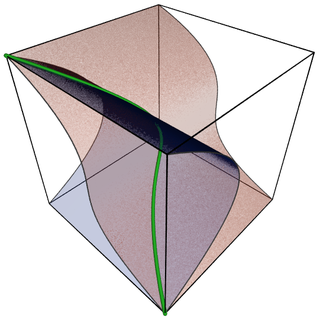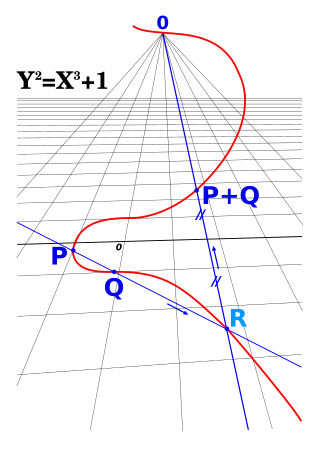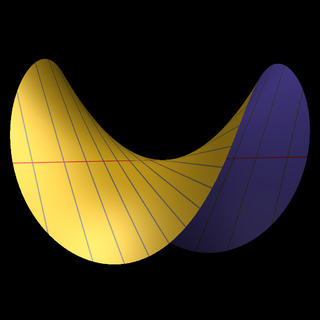The Riemann–Roch theorem is an important theorem in mathematics, specifically in complex analysis and algebraic geometry, for the computation of the dimension of the space of meromorphic functions with prescribed zeros and allowed poles. It relates the complex analysis of a connected compact Riemann surface with the surface's purely topological genus g, in a way that can be carried over into purely algebraic settings.

Algebraic varieties are the central objects of study in algebraic geometry, a sub-field of mathematics. Classically, an algebraic variety is defined as the set of solutions of a system of polynomial equations over the real or complex numbers. Modern definitions generalize this concept in several different ways, while attempting to preserve the geometric intuition behind the original definition.

In algebraic geometry, a projective variety is an algebraic variety that is a closed subvariety of a projective space. That is, it is the zero-locus in of some finite family of homogeneous polynomials that generate a prime ideal, the defining ideal of the variety.
In mathematics, and especially in algebraic geometry, the intersection number generalizes the intuitive notion of counting the number of times two curves intersect to higher dimensions, multiple curves, and accounting properly for tangency. One needs a definition of intersection number in order to state results like Bézout's theorem.
In mathematics, deformation theory is the study of infinitesimal conditions associated with varying a solution P of a problem to slightly different solutions Pε, where ε is a small number, or a vector of small quantities. The infinitesimal conditions are the result of applying the approach of differential calculus to solving a problem with constraints. The name is an analogy to non-rigid structures that deform slightly to accommodate external forces.
In mathematics, the canonical bundle of a non-singular algebraic variety of dimension over a field is the line bundle , which is the nth exterior power of the cotangent bundle on .

In mathematics, tropical geometry is the study of polynomials and their geometric properties when addition is replaced with minimization and multiplication is replaced with ordinary addition:

In algebraic geometry, a linear system of divisors is an algebraic generalization of the geometric notion of a family of curves; the dimension of the linear system corresponds to the number of parameters of the family.
In mathematics, a distinctive feature of algebraic geometry is that some line bundles on a projective variety can be considered "positive", while others are "negative". The most important notion of positivity is that of an ample line bundle, although there are several related classes of line bundles. Roughly speaking, positivity properties of a line bundle are related to having many global sections. Understanding the ample line bundles on a given variety X amounts to understanding the different ways of mapping X into projective space. In view of the correspondence between line bundles and divisors, there is an equivalent notion of an ample divisor.
In algebraic geometry, divisors are a generalization of codimension-1 subvarieties of algebraic varieties. Two different generalizations are in common use, Cartier divisors and Weil divisors. Both are derived from the notion of divisibility in the integers and algebraic number fields.

In mathematics, blowing up or blowup is a type of geometric transformation which replaces a subspace of a given space with the space of all directions pointing out of that subspace. For example, the blowup of a point in a plane replaces the point with the projectivized tangent space at that point. The metaphor is that of zooming in on a photograph to enlarge part of the picture, rather than referring to an explosion. The inverse operation is called blowing down.
In algebraic geometry, the Kodaira dimensionκ(X) measures the size of the canonical model of a projective variety X.
In algebraic geometry, a line bundle on a projective variety is nef if it has nonnegative degree on every curve in the variety. The classes of nef line bundles are described by a convex cone, and the possible contractions of the variety correspond to certain faces of the nef cone. In view of the correspondence between line bundles and divisors, there is an equivalent notion of a nef divisor.
In mathematics, the Abel–Jacobi map is a construction of algebraic geometry which relates an algebraic curve to its Jacobian variety. In Riemannian geometry, it is a more general construction mapping a manifold to its Jacobi torus. The name derives from the theorem of Abel and Jacobi that two effective divisors are linearly equivalent if and only if they are indistinguishable under the Abel–Jacobi map.
In algebraic geometry, flips and flops are codimension-2 surgery operations arising in the minimal model program, given by blowing up along a relative canonical ring. In dimension 3 flips are used to construct minimal models, and any two birationally equivalent minimal models are connected by a sequence of flops. It is conjectured that the same is true in higher dimensions.
In algebraic geometry, the minimal model program is part of the birational classification of algebraic varieties. Its goal is to construct a birational model of any complex projective variety which is as simple as possible. The subject has its origins in the classical birational geometry of surfaces studied by the Italian school, and is currently an active research area within algebraic geometry.
In algebraic geometry, a morphism between algebraic varieties is a function between the varieties that is given locally by polynomials. It is also called a regular map. A morphism from an algebraic variety to the affine line is also called a regular function. A regular map whose inverse is also regular is called biregular, and the biregular maps are the isomorphisms of algebraic varieties. Because regular and biregular are very restrictive conditions – there are no non-constant regular functions on projective varieties – the concepts of rational and birational maps are widely used as well; they are partial functions that are defined locally by rational fractions instead of polynomials.
This is a glossary of algebraic geometry.
In algebraic geometry, a contraction morphism is a surjective projective morphism between normal projective varieties such that or, equivalently, the geometric fibers are all connected. It is also commonly called an algebraic fiber space, as it is an analog of a fiber space in algebraic topology.
In mathematics, derived noncommutative algebraic geometry, the derived version of noncommutative algebraic geometry, is the geometric study of derived categories and related constructions of triangulated categories using categorical tools. Some basic examples include the bounded derived category of coherent sheaves on a smooth variety, , called its derived category, or the derived category of perfect complexes on an algebraic variety, denoted . For instance, the derived category of coherent sheaves on a smooth projective variety can be used as an invariant of the underlying variety for many cases. Unfortunately, studying derived categories as geometric objects of themselves does not have a standardized name.



































